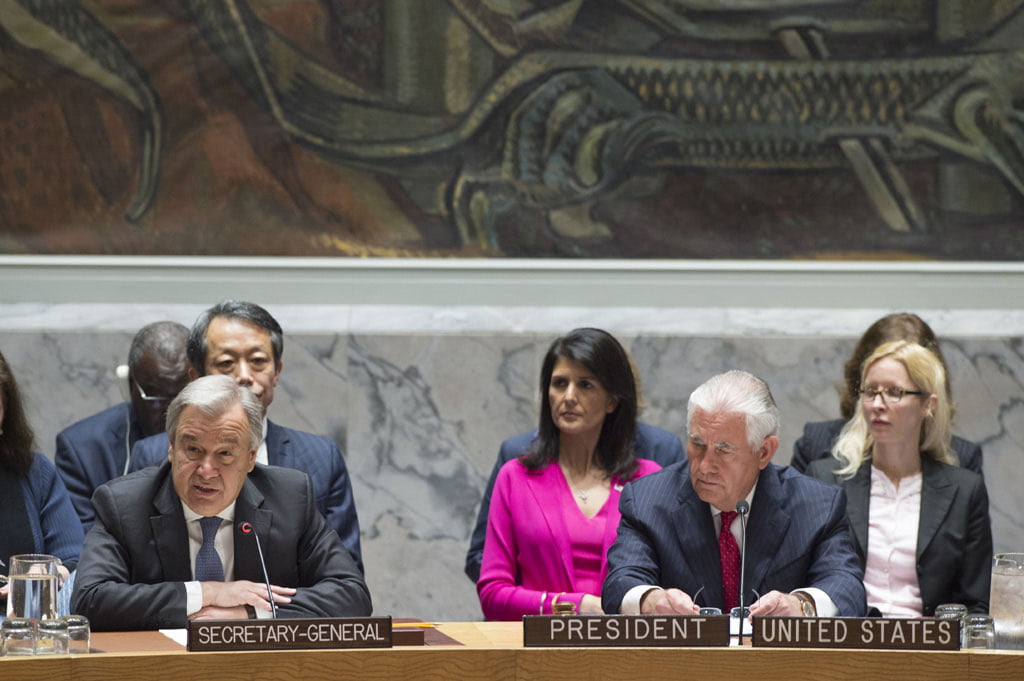In a special meeting of the United Nations Security Council today, Secretary of State Rex Tillerson offered the Trump administration’s clearest articulation yet of the United States’ strategy on North Korea. So did his Chinese counterpart, foreign minister Wang Yi.
The two strategies share the same goal: a denuclearized Korean peninsula. How they get there is profoundly different.
The American Strategy. As articulated by Tillerson, the United States intends on reaching its goal of a denuclearized North Korea through ramping up international pressure on the regime and forcing them to the negotiating table. Tillerson called for a new “pressure campaign” around three key points. First, countries more robustly implement the sanctions that already exist; second, countries downgrade or suspend diplomatic relations with North Korea; third countries impose new sanctions to further financially squeeze Pyongyang. Tillerson apparently believes that this increased pressure can bring Pyongyang to the negotiating table. But, importantly, the Trump administration is attaching pre-conditions to new any new talks. “North Korea must take concrete steps to reduce the threat that its illegal weapons programs pose to the United States and our allies before we can consider talks,” he said.
The Chinese Strategy. Chinese foreign minister Wang Yi spoke after Tillerson at the meeting. He urged the Security Council to coalesce around a plan that Beijing has been promoting for the past several weeks, known as “suspension for suspension.” Under this plan, The United States would suspend its joint military exercises with South Korea while North Korea would suspend its nuclear and missile testing activities. This would provide some breathing room in which all sides could come to the negotiating table. The Chinese see this as a more likely strategy to reduce tensions and get the parties back to the negotiating table. “What is crucial today is to resume the talks,” he told reporters ahead of the Security Council meeting.
So which one will work?
Tillerson’s plan of a “new pressure campaign” will not succeed without full Chinese buy-in. Beijing remains Pyongyang’s closest international trading partner–even as Beijing grows increasingly frustrated with their neighbor. Unless there is Chinese support for Tillerson’s plan it is likely dead-on-arrival.
On the other hand, China’s intent to get the USA and DPRK back to the negotiating table as quickly as possible is served, to a certain degree, by the strategic ambiguity embedded in Tillerson’s statement around the pre-conditions to negotiation. “Concrete steps” to reduce the threat of North Korea’s nuclear program could mean many things, including potentially agreeing to a kind of “suspension” that China has proposed. So, there is definitely some room for agreement.
Finally, the meeting at the Security Council today was a reminder that the United Nations — and diplomacy more broadly — are valuable tools of the US national security toolbox. Yet despite the centrality of the UN to US policy on North Korea, the Trump administration is still seeking big cuts to the world body. To make matters worse, news leaked today that Tillerson is planning on cutting thousands of jobs at the State Department. These cuts could directly undermine Tillerson “new pressure campaign” on North Korea — after all, the heavy lifting of this pressure campaign will be done by both American diplomats in the State Department and international bureaucrats employed by the United Nations.
Sharply reducing the capacity of the United Nations and the State Department to perform their duties is a prescription for policy failure. And “policy failure” when it comes to North Korea could lead to an unfathomable outcome.
